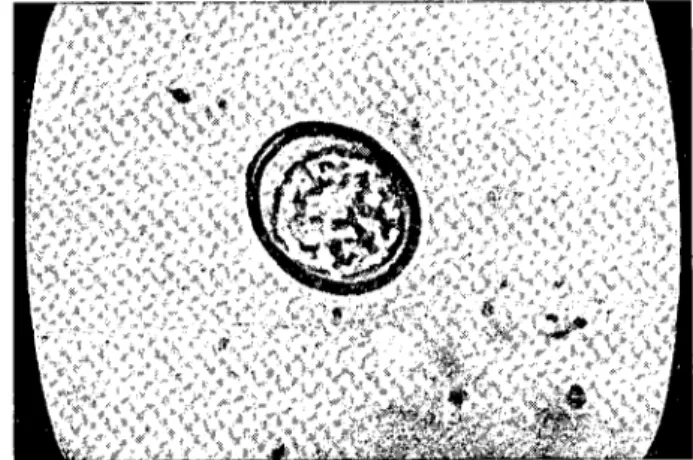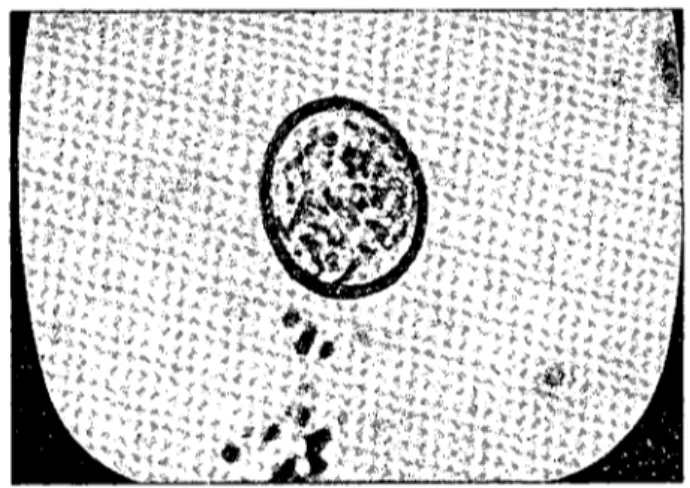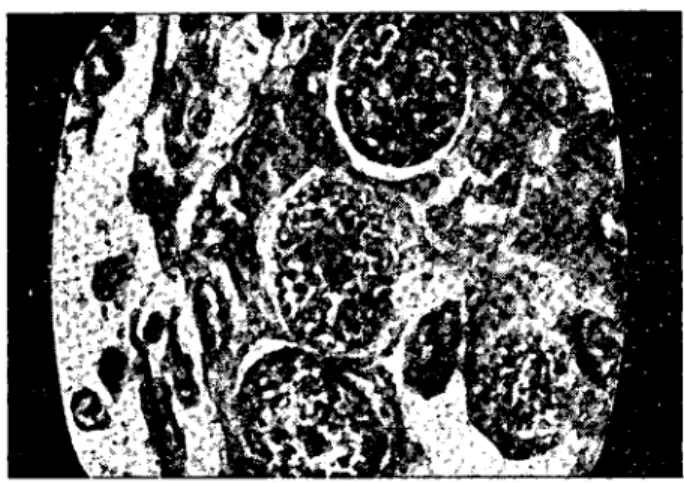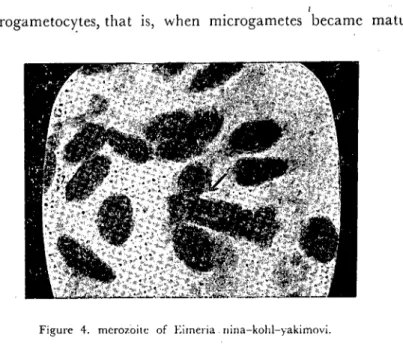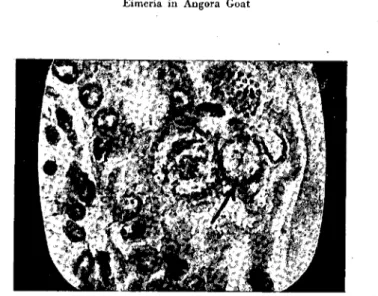Faculty oj Veterinary Medicine, Department of Protozoologv, Arthropodologv and Control of Parasitic Diseases
EIMERIA NINA-KOHL-YAKIMOVI YAKIMOF
AND RASTEGAIEFF, 193° IN AN ANGORA GOAT
Fahri Sayın*
Coccidiosis of domestic animals has been studied extensively but not in an equal degree in all species. Chicken coccidiosis, for example, has been studied a great deal, while coccidiosis in cattle, sheep and goats has received very little attention.
For a long time many authors have written about the danger of coccidiosis in sheep and goats I, 2, 3, 7, 8, 9, ıı,13, 14. According to
several 'of them 9, 16, 20 mortality in lambs and kids from coccidiosis
is 10
%
to go%
.In Turkey coccidiosis is wide spread amongAngora goats, especially among the young' animals, in which it causes emaciation, stunding and eve n death 17. Little work has
been done on the coccidiosis in Angora goats up to present time. This indicates that the coccidia and the disease they cause need to be studied in detai!.
The oocyst of Eimeria nina-kohl-yakimovi has been deseri-bed from sheep and gaots in many countries including Turkey 2,4,5, 14, 15, 16, 17, 1S,21. The life cycle and pathogenecity of this species were
also studied in sheep 14 and ordinary goats 2. But no data on its
pathogenecity and endogenous stage in Angora goats is available. It is the purpose of the present paper to record the findings of a study on the endogenous stage of Eimeria nina-kohl-yakimovi and its oocyst in the kid of Angora goal.
Material and Methods
In May, 1963, several new-bom kids of Angora goats have been purchased from Lalahan Animal Breeding Research Institute to study the pathogenecity and the endogenous development of Ei-meria parva experimentally. One of the kids became ill one week be-fore the begining of the experiment and began to discharge soft * Dr. Med. Vet., Faculty of Vcteriııary Medicine, Department of Protozoology, Arthropodology and Control of Parasitic Diseases. Ankara-Turkey.
feces and the oocyst of Eimeria. The oocysts excreted were pure and were identified as Eimeria nina-kohl-yakimovi Yakimof and Ras-tegaieff, ı930. The kid was sacrified to study the endogenous stage of the parasite and the changes in the ali'mentary tract of the ani-maL. Portions of the intestine and other organs were fixed in ı
°
%
formalin and sections wcre stained with haematoxilene-eosine for hİstologic examination and fecal sample was prepared for further study. Fecal sample \vas mixed with 2.5 per cent Potassium Dich-romate solution and placed in a thin layer in a petri dish for 2 weeksto permit the coccidian oocyst to sporulate. It was then stored in the refrigerator. The oocysts were concentrated by fiotation witlı Sheather's sugar solution prior to examination. They were ex-amined with a Leitz microscope equipped with apochromatic objec-tives. The pictures of the parasite were taken wİth Beck Micropho-tography apparatus.
Results
Onlyone species of Eimeria, Eimeria nina--kohl-yakimovi Yakimof and Rastegaieff, ı93°, was seen in the feces of the kid. The same species was also seen on the subsequent examination of fecal samples from other Angora goatsin the hcrds in the vicinity of An-kara. Since there are apparcntly no complate detailed descriptions of the sporulated oocysts of Eimeria nina-kohl-yakomavi Yakimof and Rastegaieff, ı930 from Angora goats, these are given below. The oocysts of this species were round, rardy short ovai (Fig. ı). One hundred twenty five oocysts measured 2 ı to 28 by ı8 to 24
Fig. 1 U nsporulated oocyst of Eimcria nina-kohl-.yakimovi
F. Sayın
microns with a mean of 24. i by 2I. i mierons. Their length-width ratio was 1.4 mierons. The \vall was smooth, double eontoured, eolorless, i to 1.5 mierons thiek. A micropyle was absent or imper-ceptiple. There was no mi~ropylar cap. Sporulation time was 60 hours at a temperature of 20 eentigrate. The sporoeysts were oval, round or egg shaped. They measured 4 to i 2 by 4 to 7 mierons. The
sporo-zoites were eomma- shaped or pear-slıaped. An ooeyst polar gra-nule and ooeyst residium were absenL A residual body in the sporo-cyst was presen t (Fig. 2).
Fig. 2 : Sporulated oocyst of Eiıncria nina- kohl-yakiınovi.
This speeis of Eimeria was found to be prescnt in 207 (23 (jt'o) out of goo Angora goats whieh w(~rc from the vieinity of Ankara.
Patlıologic changes:
The gross lesions in the intestine eonsisted of numerous diffuscly-seattered, round, smooth white plaques approximately 0.2 to 0.3
mm. in diameters in mueosa. The border of these lesions were dis-tinet and regular in outline. The plaques themselves neither raised nor depressed below the surfaee of unaffeeted mueosa. The mueosa was slightly thiekened throughout the intestine. Neither eongestion, haemorrhage nor exeess mueus were presenL The feces of the kid was soft and did not eontain blood. There was no haemorrhagie content in the intestine either.
Seetions of smail intestine, ceeum and eolon were examined. Slight to moderate enteritis \Vas presenL The ecllular reaetio'l eon-sisted of lymphoeytes and polymorphonuclear leueoeytes. The
pa-rasites destroyed the epithclial eeııs in whieh they developped and eaused the denudation of lamina epithelialis.
Numerous matuı'e cacidian rriaerogametes, mierogametoeytes sehizonts, ooeysts were present in the epithelial eclis of ileum, ee-eum and upper part of the large intestine. Merezoites were also seen in the smears were made of smaıı intestine.
One type of sehizont was present (Fig.3). They were ellipsoid or round in shape and measured 31 to 43 by 22 to 31 microns, with a
mean of 37.0 by 26.5 mierons. Aıı of the m eontained the nudei regularly distributed through the whole sehizonL Each nudei seems to be separated by a dear zone from the eytoplasma of sehizont.
Fig. 3 : schizonts of Eimcria nina-kohl-yakimovi.
The merozoites were obtained in the fresh smears from the in-testine of the kid (Figure 4). They were straight with one end rather bluntly rounded and other drown more. They meassured i i by i
mierons. No free merozoites were found in the seetions. .
There were no early maerogametes but few mature ones were seen in the epithelial eeııs of the side of wiııi (Figure 5)' The mature maerogametes contained a large number of granulcs about i
rriic-ron in diameter. Their nudeus lay at the center of the eell. They measured 9 to 18 by 7 to 13 mierons with a mean of 13.5 by ıo mic-rons.
The nudei in the mierogametocytes seattered regularly and they were not separated by a dear zone from the eytoplasma of mic-rogametocyte. The mierogametes lay in whorls on the surface of
F. Sayın
i
the microgametoc~tes, that ıs, when microgametes became mature,
Figure 4. merozaiıc of Eimeria rıirıa-kolıl-yakimovi.
Figurc 5. macrogameles of Eimeria nina-kohl-yakimovi.
some residual material remained in the center of the latter (Figure 6) Th~ microgametocyte measured 20 to 25 by 15 to 18 mıcrons with a me an of 22.5 by 16.5 microns.
The young oocysts differed from the maturc macrogametes in which the palastic granulcs of the latter coalesced to form the oocyst wall (Figure 7). The young oocyts in the sections were i9 to 24
by i i to 20 microns in diameter with a mean of 21.5 by 18.5 mic-rons in diameter. 140
i
i !i
Eimcria in Angora Goat
Figurc G. mierogametoeyte of Eimerİa nİna-kohl-yakİmovİ.
Şekil 7. young ooeysts of Eimerİa nina-kohl.-yakimovİ in tİssuc.
Dİscussİon
The question may arise as to which species of Eimeria the en-dogenous stage belongs. Althongh the kid passed out the pure oocysts of Eimeria nina-kohl-yakomavi, this docs not necessarilly mean that the stage of Eimeria belongs to that species. The schizonts, mic-rogametocytes and oocysts do not resemble both in morphology and in location those described by Lotze 13 for Eimeria arloingi İn
sheep and by Levine at al l2 for Eimeria arloingi in goats. The
F. Sayııı
sehizonts were not similar, either, to the giant sehizonts whieh have been reported for Eimeria nina-kohl-yakimovi 14, Eimeria parva
in sheep 10 and in Angora goats 17 They also differ in their
sizes from the small sehizonts from sheep 10 and Angora gü<i-ts17.
The sehizonts from goats were described by Balozet 2 for
Eimeria nina kohl-yakimcvi .. These measured i5 to 35 mierons.
Eaeh nuclei in them was separated by a clear zane from the eytoplasm. The sehizonts from the kid in this study resemble thesc. The mierôga-metoeytes found in the present seetions were also similar with respeet to their sizes and positions of their nuclei to those described by Balozet 2 from kids. The mature maerogametes and young ooeysts
earrying mieropular eap described by Balozet 2 for Eimeri
nina-kohl-yakimovi from kids were not present in the Angora kid exa-mined in this study. The maerogametes in our seetions resemble both in morphology and loeation those mentioned by Lotze 14 for
Eimeria nina-kohl-yakimovi.
Summary
Ooeysts of Eimeria nina-kohl-yakimovi were found in the feees of an Angora kid, with lessions of eoeeidiosis in the small intes-tine. The ooeyst is described in detai1. They were round, rarely short-oval, and measured 21 to 28 byı8 to 24 mierons and contai-ned oval rou nd or egg sha pe sporoeysts measuring 4 to i2 by 4 to
to 7 mierons. The ooeysts of this speeies were found in the fCees of 207 (23 %) out of goo Angora goats.
Endogenous stages in the small intestine, eeeum and upper eolon included seehizonts, merozoites, macrogametes, mierogame-toeytes and ooeyst in the epithclial eeııs. These are also described in netaiJ.
Öze t
Tiftik keçilerinde Eimeria parva'nın patojenitesi ve biyolojisini incelemek üzere satın alınan deneme oğlaklarından birinde tabii eoeeidiosis zuhur etmiştir. Oğlakta görülen hafif bir ishal'i müteakip yapılan gaita muayenesinde bol miktarda saf Eimeria nina-kohl-yakimovi ooeystleri tesbit edilmiştir. Mevcut literatürlere göre An-kara keçilerinde bu türün asexual ve sexual gelişme devirleri ince-lenmemiştir. Bu hususları etüt etmek maksediyle oğlak öldürülmüş ve üzerinde gereken muayeneler yapılmıştır.
Gaitada görülen oocystler yuvarlak veya oval, çift cidarlıdır. Mikropil ve kep yok'tur. 21-28 mikron uzunlukta, i8-24 mikron
genişliktedir. Oocyst protoplasma bakiyesi yoktur. Sporocyst'ler ovaldir. 4-12 mikron uzunlukta ve 4.-7 mikron genişliktedir. Spo-r'ocyst protoplasma bakiyesi vardır. Ankara ve civarında yapılan sürveyde 900 ankara keçisinden 207 (% 23)) sinin gaitasında bu türün oocystlerine rastlanmıştır.
Öldürülen oğlağın ince barsak ve sekum makozasında yaygın ve toplu iğne başı cesametinde, küçük, beyazımsı derenler görülmüş-tür. Barsak da herhangi bir kanamaya rastlanmamıştır. Sadece mukozada kalınlaşma tesbit edilmiştir.
Barsak mukozasından yapılan taze frotilerdemerozoite'ler gö-rülmüş ve ebatları ortalama rixi mikron olarak tesbit edilmiştir.
Schizont'lara ince barsak, kalın barsak ve sekum'dan yapılan kesitlerde rastlanmıştır. Schizont'lar bilhassa epitel hücreleri içinde görülmüş, uzunlukları 3i-43, genişlikleri 22-3 i mikron olarak bulunmuştur.
Barsak mukozasının epitel hücrelerinde, schizont'ların görüld0ğü yerlerde macrogamete, microgametocyte, genç oocyst'ler de tesbit edilmiştir.
Referenees
i . Antipin, D. N.; V. S. Ershow; N. A. Zolatarev and V. A.
Salyaev (I 956): Parasitology and Parasitic diseases oj Livestock State publİshİng House for Agrİculturel literature, Moscow.
2. Balozet, T. (1932): Les coccidies du mouton et de la chevre. Cycle evelotive de E. nina-kohl-yakimovi Takimoj et Rastegaive, 1930. Arc-hİves de i' Institue Pasteur de Tunus XXi, 1. 88-118.
3. Beeker, E. R. (I 934): Coccidia and coccidiosis qf domesticated game, laboratoıy animals and qf man. Collegİate Press Ine. lowa, Ame-rıca.
4. Beeklund, W. W. ( 1957): An epizootic
if
cocidiosis in western jeeder lambs in Georgia. North Amer. Vet. 38, 262-264.5. Christensen, J. F. (I 938): Species difjerentiation in the coccidia from the domestic sheep.
J.
Parasİto!. 24, 5, 453-468.6. Davis, L. R.; G. W. Bowman; W. N. Smith (1963): Obser-vation on the endogenous cycle oj Eimeria ahsata Honess, 1942 in do-mestic sheep.
J.
Parasİto!. ıo: supplement, 8.7. Davies, S. F. M.; L.P. Joyner and S. B. Kenda11(1963): Coccidiosis. OIİver and Boyd, Edingburg.
F. Sayın
8. Deonı,
J.; J.
Morteıınıans (I 956) : Observation sur la coccidiosise du mouton et de la chevre au Congo Belge. Ann. Soc. Belge. Med. Trop. 36: 47-57.9. Foster, A. O. (1949): The economic losses due to coccidiosis. Ann .. N. Y. Acad. Sci. 52, 468-472.
io. Kodan, A~; L. Pellerdy und L. Verse~yi (I 95i ) :
Experimen-telle studien über die kokzidiose der schafe, I. die endogene enıwicklung von E. parva. Acad. Vet. Budapeşt. V. i (3) 3i7-33 ı.
i i • Levine, N. D. (I 96 I): Protozoon parasiles of domestic animals and
of man. Burgess Publishing Company.
12. Levine, N. D.; V. İvens, and T. E. Frits, (1962): Eimeria christensini sp. n. and other cocidia of goat.
J.
Parasitol. 48, 2. 255-269.13. Lotze,
J.
C. (1953): Life histoıy of tlze coccidian parasite, Eimeria arloingi, in domestic sheep,.J.
Amcr. Vet. Res. XIV, 50, 86-95.14. Lotze,
J.
C. (I 953): The palogenicity of the coccidian parasite E. ninakohlyakimovi in domestic sheep. Amer. V ct. Med. Ass. ninetienth Ann. Meeting (prociding book) 141-'146.15. Melikyan, E. L. (I 955): Coccidiosis of sheep and goats in the Ar-menian S. S. R., Trud Armeniyan Nauchno-Issled Vet. Inst. 8: 83-91.
16. Merdivenci, A. (I 959): Evcil koyun ve keçilerimide coccidia nevi-leri ve bazı deneyler. Türk. Vet. Hek. Der. Dergisi. 20: 260-28 ı. 17. Sayın, F. (I 964): Tiftik keçilerinde bulunan Eimeria türleri. E. parva'nın biyolojisi üzerinde deneysel araştırmalar. Tez, A. Veteriner
Fakültesi. Henüz basılmamıştır.
18. Shunıard, B. F. (I 957): Studies on ovine coccidiosis. Some. physi-ological changes taking place in experimental infections with E. nına-kohl-yakomivi and E. faurei.
J.
paristol. v, 43, 5. 548-554.19. Smith, W. N.; L. R. Davis (1960): The life cyle of Eimeria ahsata.
J.
protozool. 7 (suppl.) 8.20. Svanbaev, S. K. (I 957): K Voprosu o fauna i moıfol~ji koktsidii ovetsi koz zapodnogo kazakhstane, Trudy Instituta zoologii Akad. Nauk Kazakh S. S. R. Tom, VII, 252-257.
2r • Yakinıof, W. L. (I933): La coccidiose des animaux domesıiques dans l' Azerbaidjan. Antı. Soc. BeL. Med. Trop. 13, 93- i30.
